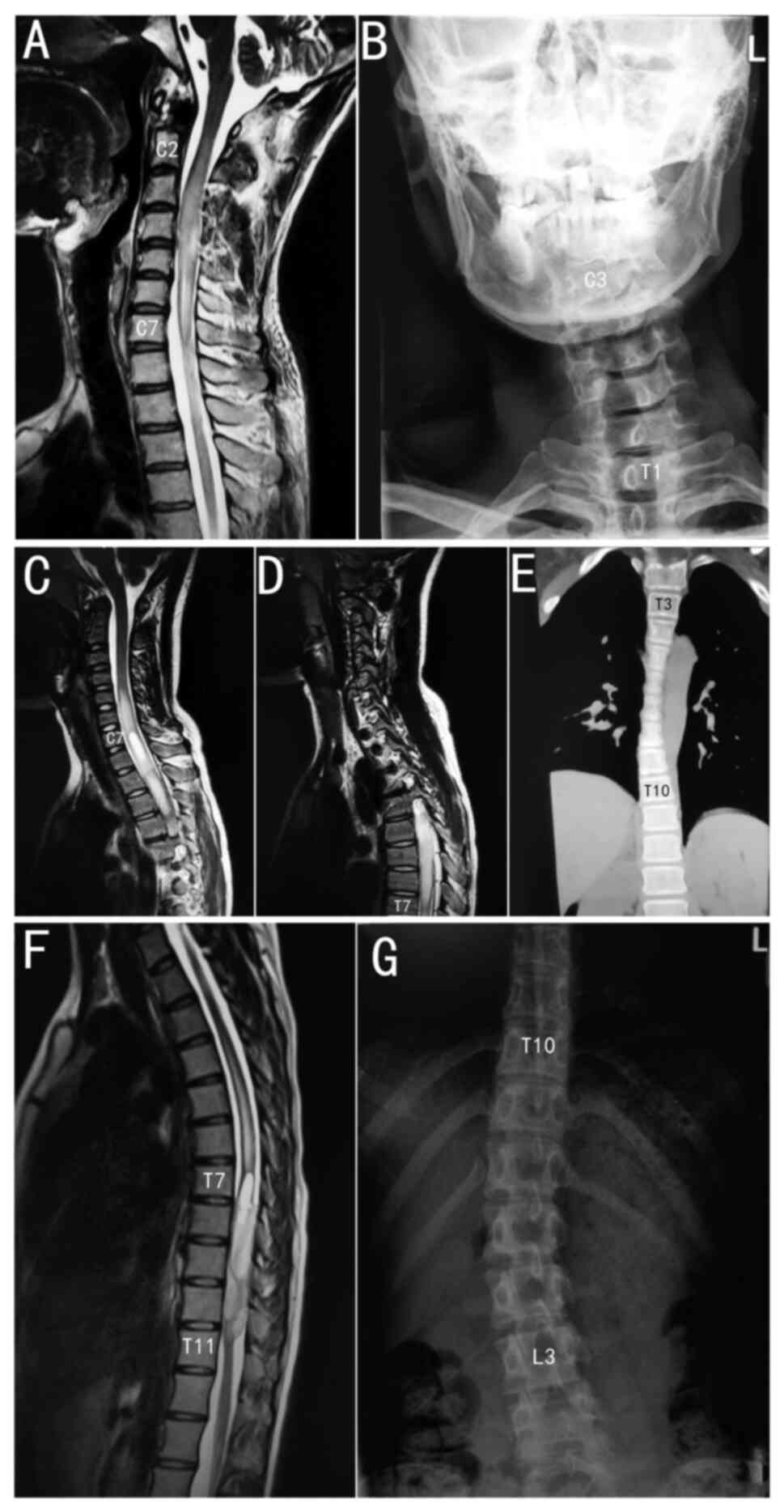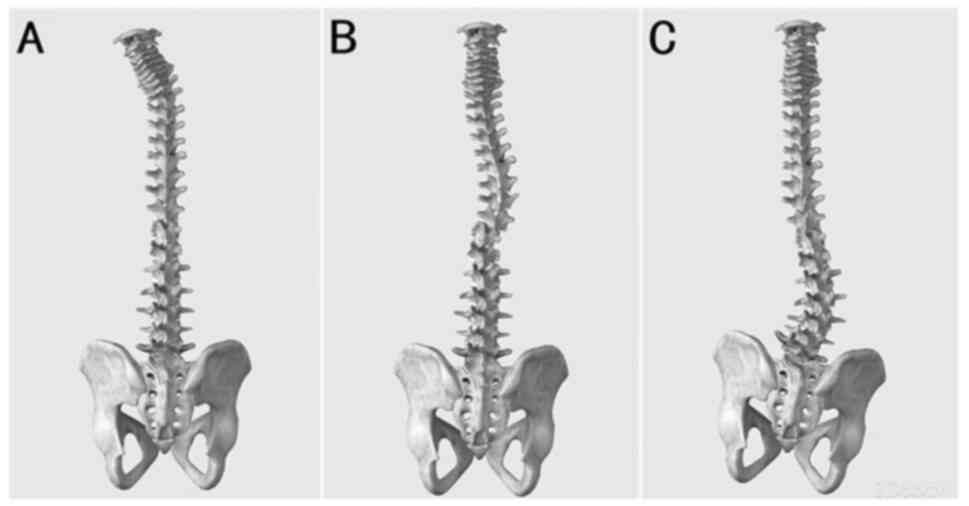|
1
|
Mccann KS and Kelham SA: Scoliosis. JAAPA.
35:57–58. 2022. View Article : Google Scholar : PubMed/NCBI
|
|
2
|
Heyde CE and Putzier M: Neuromuscular
scoliosis. Orthopade. 50:605–607. 2021.(In German). View Article : Google Scholar : PubMed/NCBI
|
|
3
|
Kuznia AL, Hernandez AK and Lee LU:
Adolescent idiopathic scoliosis: Common questions and answers. Am
Fam Physician. 101:19–23. 2020.PubMed/NCBI
|
|
4
|
Yang H, Im G, Zhu C, Osorio C, Masood U,
Zhou C, Yang X, Liu L and Song Y: Unplanned surgery of congenital
scoliosis. Chin Med J (Engl). 135:374–376. 2021. View Article : Google Scholar : PubMed/NCBI
|
|
5
|
de Reuver S, van der Linden PP, Kruyt MC,
Schlosser T and Castelein RM: The role of sagittal pelvic
morphology in the development of adult degenerative scoliosis. Eur
Spine J. 30:2467–2472. 2021. View Article : Google Scholar : PubMed/NCBI
|
|
6
|
Wishart BD and Kivlehan E: Neuromuscular
scoliosis: When, who, why and outcomes. Phys Med Rehabil Clin N Am.
32:547–556. 2021. View Article : Google Scholar : PubMed/NCBI
|
|
7
|
Slattery C and Verma K: Classifications in
Brief: The lenke classification for adolescent idiopathic
scoliosis. Clin Orthop Relat Res. 476:2271–2276. 2018. View Article : Google Scholar : PubMed/NCBI
|
|
8
|
Blevins K, Battenberg A and Beck A:
Management of scoliosis. Adv Pediatr. 65:249–266. 2018. View Article : Google Scholar : PubMed/NCBI
|
|
9
|
Mesiti BL: Scoliosis: An overview. Radiol
Technol. 93:55–72. 2021.
|
|
10
|
Oetgen ME, Heyer JH and Kelly SM:
Scoliosis screening. J Am Acad Orthop Surg. 29:370–379. 2021.
View Article : Google Scholar : PubMed/NCBI
|
|
11
|
Acaroglu E, Akel I, Alanay A, Yazici M and
Marcucio R: Comparison of the melatonin and calmodulin in
paravertebral muscle and platelets of patients with or without
adolescent idiopathic scoliosis. Spine (Phila Pa 1976).
34:E659–E663. 2009. View Article : Google Scholar : PubMed/NCBI
|
|
12
|
Stetkarova I, Zamecnik J, Bocek V, Vasko
P, Brabec K and Krbec M: Electrophysiological and histological
changes of paraspinal muscles in adolescent idiopathic scoliosis.
Eur Spine J. 25:3146–3153. 2016. View Article : Google Scholar : PubMed/NCBI
|
|
13
|
Riddle HF and Roaf R: Muscle imbalance in
the causation of scoliosis. Lancet. 268:1245–1247. 1955. View Article : Google Scholar
|
|
14
|
Tabibkhooei A, Sadeghipour A and Fattahi
A: Thoracolumbar pilomyxoid astrocytoma concomitant with spinal
scoliosis: A case report and literature review. Surg Neurol Int.
10:2352019. View Article : Google Scholar
|
|
15
|
Zhang D, Fan W, Zhao X, Massicotte EM and
Fan T: Long-level intramedullary spinal cord astrocytoma
complicated with spine scoliosis: Report of two cases. Int J Surg
Case Rep. 79:234–238. 2021. View Article : Google Scholar : PubMed/NCBI
|
|
16
|
Parsa AT, Lee J, Parney IF, Weinstein P,
Mccormick PC and Ames C: Spinal cord and
intradural-extraparenchymal spinal tumors: Current best care
practices and strategies. J Neurooncol. 69:291–318. 2004.
View Article : Google Scholar
|
|
17
|
Zulch KJ: Principles of the new World
Health Organization (WHO) classification of brain tumors.
Neuroradiology. 19:59–66. 1980. View Article : Google Scholar : PubMed/NCBI
|
|
18
|
Kleihues P, Burger PC and Scheithauer BW:
The new WHO classification of brain tumours. Brain Pathol.
3:255–268. 1993. View Article : Google Scholar
|
|
19
|
Kleihues P, Louis DN, Scheithauer BW,
Rorke LB, Reifenberger G, Burger PC and Cavenee WK: The WHO
classification of tumors of the nervous system. J Neuropathol Exp
Neurol. 61:215–225. 226–229. 2002. View Article : Google Scholar
|
|
20
|
Louis DN, Ohgaki H, Wiestler OD, Cavenee
WK, Burger PC, Jouvet A, Scheithauer BW and Kleihues P: The 2007
WHO classification of tumours of the central nervous system. Acta
Neuropathol. 114:97–109. 2007. View Article : Google Scholar
|
|
21
|
Louis DN, Perry A, Reifenberger G, von
Deimling A, Figarella-Branger D, Cavenee WK, Ohgaki H, Wiestler OD,
Kleihues P and Ellison DW: The 2016 World Health Organization
Classification of Tumors of the Central Nervous System: A summary.
Acta Neuropathol. 131:803–820. 2016. View Article : Google Scholar
|
|
22
|
Louis DN, Perry A, Wesseling P, Brat DJ,
Cree IA, Figarella-Branger D, Hawkins C, Ng HK, Pfister SM,
Reifenberger G, et al: The 2021 WHO Classification of tumors of the
central nervous System: A summary. Neuro Oncol. 23:1231–1251. 2021.
View Article : Google Scholar
|
|
23
|
Shafaq N, Suzuki A, Matsumura AC, Terai H,
Toyoda H, Yasuda H, Ibrahim M and Nakamura H: Asymmetric
degeneration of paravertebral muscles in patients with degenerative
lumbar scoliosis. Spine (Phila Pa 1976). 37:1398–1406. 2012.
View Article : Google Scholar : PubMed/NCBI
|
|
24
|
Canbay S, Gurer B, Bozkurt M, Comert A,
Izci Y and Baskaya MK: Anatomical relationship and positions of the
lumbar and sacral segments of the spinal cord according to the
vertebral bodies and the spinal roots. Clin Anat. 27:227–233. 2014.
View Article : Google Scholar
|
|
25
|
Zaydman AM, Strokova EL, Kiseleva EV,
Suldina LA, Strunov AA, Shevchenko AI, Laktionov PP and Subbotin
VM: A New look at etiological factors of idiopathic scoliosis:
Neural Crest Cells. Int J Med Sci. 15:436–446. 2018. View Article : Google Scholar
|
|
26
|
Ruwald JM, Eymael RL, Upenieks J, Zhang L,
Jacobs C, Pflugmacher R and Schildberg FA: An overview of the
current state of pediatric scoliosis management. Z Orthop Unfall.
158:508–516. 2020. View Article : Google Scholar
|
|
27
|
Cheung J, Veldhuizen AG, Halberts JP,
Sluiter WJ and Van Horn JR: Geometric and electromyographic
assessments in the evaluation of curve progression in idiopathic
scoliosis. Spine (Phila Pa 1976). 31:322–329. 2006. View Article : Google Scholar : PubMed/NCBI
|
|
28
|
Tsai YT, Leong CP, Huang YC, Kuo SH, Wang
HC, Yeh HC and Lau YC: The electromyographic responses of
paraspinal muscles during isokinetic exercise in adolescents with
idiopathic scoliosis with a Cobb's angle less than fifty degrees.
Chang Gung Med J. 33:540–550. 2010.PubMed/NCBI
|
|
29
|
Yarom R and Robin GC: Studies on spinal
and peripheral muscles from patients with scoliosis. Spine (Phila
Pa 1976). 4:12–21. 1979. View Article : Google Scholar : PubMed/NCBI
|
|
30
|
Kawaguchi K, Obayashi J, Koike J, Tanaka
K, Seki Y, Nagae H, Ohyama K, Furuta S, Valsenti G, Pringle KC and
Kitagawa H: Muscle imbalance as a cause of scoliosis: A study in a
fetal lamb abdominal wall defect model. Pediatr Surg Int.
37:1755–1760. 2021. View Article : Google Scholar
|
|
31
|
Carry PM, Duke VR, Brazell CJ, Stence N,
Scholes M, Rousie DL and Hadley MN: Lateral semi-circular canal
asymmetry in females with idiopathic scoliosis. PLoS One.
15:e2324172020. View Article : Google Scholar
|
|
32
|
Antoniadou N, Hatzitaki V, Stavridis S and
Samoladas E: Verticality perception reveals a vestibular deficit in
adolescents with idiopathic scoliosis. Exp Brain Res.
236:1725–1734. 2018. View Article : Google Scholar : PubMed/NCBI
|
|
33
|
Ng A, Pizer B and May P: Congenital spinal
astrocytoma: How favourable is the long-term outcome? Br J
Neurosurg. 14:366–370. 2000. View Article : Google Scholar : PubMed/NCBI
|
|
34
|
Catanzariti JF, Agnani O, Guyot MA,
Wlodyka-Demaille S, Khenioui H and Donze C: Does adolescent
idiopathic scoliosis relate to vestibular disorders? A systematic
review. Ann Phys Rehabil Med. 57:465–479. 2014. View Article : Google Scholar : PubMed/NCBI
|
|
35
|
Biczok A, Strubing FL, Eder JM,
Egensperger R, Schnell O, Zausinger S, Neumann JE, Herms J, Tonn JC
and Dorostkar MM: Molecular diagnostics helps to identify distinct
subgroups of spinal astrocytomas. Acta Neuropathol Commun.
9:1192021. View Article : Google Scholar : PubMed/NCBI
|
|
36
|
Yeung KH, Man G, Shi L, Hui S, Chiyanika
C, Lam TP, Ng B, Cheng J and Chu W: Magnetic resonance
imaging-based morphological change of paraspinal muscles in girls
with adolescent idiopathic scoliosis. Spine (Phila Pa 1976).
44:1356–1363. 2019. View Article : Google Scholar : PubMed/NCBI
|
|
37
|
Park Y, Ko JY, Jang JY, Lee S, Beom J and
Ryu JS: Asymmetrical activation and asymmetrical weakness as two
different mechanisms of adolescent idiopathic scoliosis. Sci Rep.
11:175822021. View Article : Google Scholar : PubMed/NCBI
|
|
38
|
Fadzan M and Bettany-Saltikov J:
Etiological Theories of adolescent idiopathic scoliosis: Past and
present. Open Orthop J. 11:1466–1489. 2017. View Article : Google Scholar : PubMed/NCBI
|
|
39
|
Peng Y, Wang SR, Qiu GX, Zhang JG and
Zhuang QY: Research progress on the etiology and pathogenesis of
adolescent idiopathic scoliosis. Chin Med J (Engl). 133:483–493.
2020. View Article : Google Scholar : PubMed/NCBI
|
















